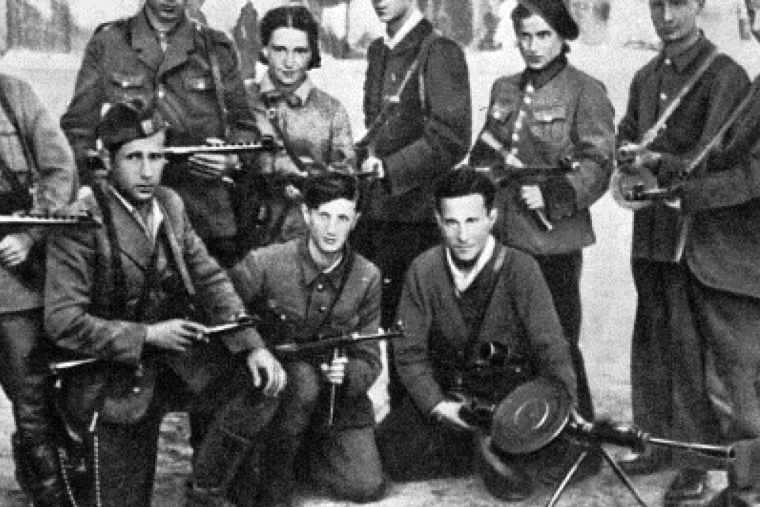 During World War II, 30,000 Jewish partisans fought in Eastern Europe, in their own combat units. In Western Europe, where anti-semitism among the conquered gentile population was less severe, Jews were able to participate as individuals in the national resistance, rather than having to fight in separate units. For example, in France, Jews amounted to less than one percent of French population, but comprised about 15 to 20 percent of the French Resistance. One of the most successful battles of the Jewish resistance was the Warsaw Ghetto Uprising. Nearly every Jew who participated was eventually killed — but they were going to be killed anyway. By choosing to stand and fight, the Warsaw Jews diverted a significant amount of Nazis resources from battlefields elsewhere, thus hastening the Nazi defeat.
During World War II, 30,000 Jewish partisans fought in Eastern Europe, in their own combat units. In Western Europe, where anti-semitism among the conquered gentile population was less severe, Jews were able to participate as individuals in the national resistance, rather than having to fight in separate units. For example, in France, Jews amounted to less than one percent of French population, but comprised about 15 to 20 percent of the French Resistance. One of the most successful battles of the Jewish resistance was the Warsaw Ghetto Uprising. Nearly every Jew who participated was eventually killed — but they were going to be killed anyway. By choosing to stand and fight, the Warsaw Jews diverted a significant amount of Nazis resources from battlefields elsewhere, thus hastening the Nazi defeat.
The following is based on my forthcoming book “The Morality of Self-Defense and Military Action: The Judeo-Christian Tradition,” which will be published in 2016 by Praeger.
Before the war, about 10 percent of Poland’s population was Jewish. In the Middle Ages, Poland had been a welcoming, tolerant and free nation, and many Jews emigrated there. But when Poland regained its independence in 1919, thanks to the Versailles Treaty, the nation degenerated into military dictatorship, and much of the population was antisemitic.
The Nazis took most of Poland in September 1939, but according to the terms of the Hitler-Stalin pact, the Soviet Union was allowed to take the eastern third of the nation. After the June 1941 German invasion of the U.S.S.R., all of Poland fell under German control.
In Eastern Europe, the Nazis followed a standard procedure. All the Jews in a city would be ordered to move into a walled ghetto. Movement in and out of the ghetto was strictly controlled. The Germans would set up a Judenrat of collaborationist Jews to run the ghetto and to punish any attempts at rebellion. The Judenrat received special privileges from the Nazis. Often, the Judenrat was told that as long as the ghetto worked hard to produce factory goods for the Germans, the ghetto would be allowed to survive.
Eventually, the Germans would begin deporting large numbers of people from the ghetto — ostensibly for resettlement in labor camps, but almost always for extermination. The Judenrat would be required to select the Jews to be deported. Eventually, the whole ghetto would be depopulated and the area would be declared Judenrein (Jew-free).
Warsaw’s large pre-war Jewish population was initially supplemented by large numbers of Jews who were shipped in from other cities. The Jews were forced to live on starvation rations, and many in the ghetto died from starvation or contagious disease. The Germans eventually cut the size of the ghetto in half, consolidating the survivors into extremely crowded conditions. Deportations to the death camps continued to depopulate the ghetto.
In late 1942, Emmanuel Ringelblum, the well-educated author of a diary about life in the Warsaw Ghetto, wrote:
Whomever you talk to, you hear the same cry: The resettlement never should have been permitted. We should have run into the street, set fire to everything in sight, have torn down the walls, and escaped to the Other Side. The Germans would have taken their revenge. It would have cost tens of thousands of lives, but not 300,000. Now we are ashamed of ourselves, disgraced in our own eyes, and in the eyes of the world, where our docility has earned us nothing. This must not be repeated now. We must put up a resistance, defend ourselves against the enemy, man and child.
[Emmanuel Ringelblum, “Notes from the Warsaw Ghetto: The Journal of Emmanuel Ringelblum,” ed. & transl., Jacob Solan (N.Y.: Schoken Books, 1958), p. 326.]
On Jan. 18, 1943, the Germans rounded up 7,000 Jews and sent them to the extermination camp at Treblinka; they killed 600 more right in Warsaw. But on that day, an uprising began. In the beginning, the Jewish Fighting Organization had about 600 volunteers; the Jewish Military Association had about 400, and there were thousands more in spontaneous small groups. The Jews had only 10 handguns, but the Germans did not realize how under-armed the Jewish fighters were.
After four days of fighting, the Germans on January 21 pulled back from the ghetto, to organize better. A diary written in the Warsaw ghetto exulted, “In the four days of fighting we had made up for the shame of Jewish passivity in the first extermination action of July, 1942.” [Ber Mark, “The Warsaw Ghetto Uprising,” in “They Fought Back” ed., Yuri Suhl (N.Y.: Paperback Library, 1968; 1st pub. 1967), pp. 104-06].
Not only the Germans were shocked by the unexpected resistance, but also the Jews were astonished. They could not imagine until then that the beaten, exhausted victims could rise against a mighty enemy who had conquered Europe. Many Jews who were in the streets of Warsaw during the fighting refused to believe that on Zamenhof and Mila streets Jewish boys and girls had attacked Germans. The large-scale fighting which followed convinced all that it was possible.
In February 1943, the Polish Home Army transferred 50 revolvers (many of them defective), 50 hand grenades, and four pounds of explosives to the Jews in the Warsaw ghetto. The Warsaw Jews also manufactured their own explosives, including Molotov cocktails. But, wrote Ringelblum, as in Biblical days, “their most potent weapon was their deep sense of national pride and responsibility.”
On Feb. 16, 1943, Heinrich Himmler ordered that the Warsaw ghetto be exterminated on April 19. The plan was to give Hitler a Judenrein Warsaw as a present for his April 20 birthday.
On that night of April 19, the Warsaw Jews partook of their Passover Seder. Since September 1939, they had eaten the bitter herbs of slavery. Now, they were drinking the wine of freedom.
The Nazi minister of propaganda, Joseph Goebbels, wrote in his diary, “the joke cannot last much longer, but it shows what the Jews are capable of when they have arms in their hands.” [Yuri Suhl, introduction to “They Fought Back,” p. 15.]
The Nazis brought in tanks. The Jews were ready with explosives. First one tank and then a second were immobilized in the middle of the street, in flames, their crews burned alive. Ringelblum recalled:
Now the fighters as well as the non-combatant Jews who have crawled out of their hiding places have reached the pinnacle of jubilation. … According to one eyewitness account, “The faces who only yesterday reflected terror and despair now shone with an unusual joy which is difficult to describe. This was a joy free from all personal motives, a joy imbued with the pride that that ghetto was fighting.”
Another eyewitness described the confusion in the German ranks: “There runs a German soldier shrieking like an insane one, the helmet on his head on fire. Another one shouts madly ‘Juden…Waffen…Juden… Waffen!’” [“Jews…weapons!”]
Eventually, the Jewish forces began to run out of ammunition. The Warsaw Jews, like the Jews throughout Europe, were unable to produce their own ammunition. There was little “gun culture” among European Jews of the 1930s, so few Jews had the equipment for “reloading” — the home manufacture of ammunition. In contrast, hundreds of thousands of American families own the machine tools used for reloading; home manufacture of ammunition is legal everywhere in the United States.
Stymied in house-to-house fighting, the Germans began to burn the ghetto to the ground on April 22. The Warsaw Ghetto fire was probably the largest urban fire in Europe since Nero’s fire in Rome. On April 23, Himmler ordered SS Major General Jürgen Stroop to finish things quickly, and Stroop promised to complete his job that same day. But he could not.
That day, a poster appeared in Warsaw in which the Jewish Fighting Organization assured the Christian Polish resistance that the Jews would never surrender. The poster promised, “You have seen and will see that every doorstop in the ghetto is and will continue to be a fortress. We may all perish in the struggle but we shall not surrender….Long live the brotherhood of weapons and the blood of fighting Poland! Long live Freedom! Death to the murderous and criminal occupants.” [Ber Mark, “The Warsaw Ghetto Uprising,” in “They Fought Back,” pp. 120-21.]
On May 16, Stroop reported that the Jewish ghetto in Warsaw “no longer exists.” Himmler ordered a celebratory event: blowing up a beautiful large synagogue which had been built in 1877. The explosion could be felt all over Warsaw. Yet on that very day, Jewish fighters carried out more attacks in Warsaw. Fighting continued until July. Some Jews managed to hide in the ghetto until August 1944, when they joined the Polish uprising that month.
The Germans suffered over a thousand casualties in the first week of fighting alone. The Germans had to spend more time subduing the Warsaw Ghetto than they did conquering the entire nations of Poland or France.
The Warsaw Jews knew they had almost no chance of survival. They decided that it was better to die fighting than to die in a gas chamber. It was better to kill at least some of the killers, than to let them massacre Jews with impunity. Ringelblum wrote, “We took stock of our position and saw that this was a struggle between a fly and an elephant. But our national dignity dictated to us that the Jews must offer resistance and not allow themselves to be led wantonly to slaughter.”
Warsaw was the first mass civilian uprising against the Nazis. On April 23, the Jewish commander, 25-year-old Mordechai Anielevich, had written, “I have a feeling that great things are happening, that what we have undertaken is of tremendous significance.”
As the West learned about the Warsaw Revolt, the Western media began to change its attitude towards Jews. “They concluded that the Jews had earned the right to be regarded not as supplicants, but as allies.” [Abram L. Sachar, “The Redemption of the Unwanted: From the Liberation of the Death Camps to the Founding of Israel” (N.Y.: St. Martin’s Pr., 1983), p. 54.] An article in Harper’s explained, “As the British press was the first to admit, the Jews now have a new and different claim for consideration, a claim not of passive victims, but of active allies and partners who have fought the common enemy.” [William Zukerman, “The Revolt in the Ghetto,” Harper’s Magazine, September 1943, p. 355.]
In Warsaw, as elsewhere, the key impediment to resistance was shortage of arms. According to Holocaust historian Abram L. Sachar: “The indispensable need, of course, was arms. As soon as some Jews, even in the camps themselves, obtained possession of a weapon, however pathetically inadequate—a rifle, an ax, a sewer cover, a homemade bomb—they used it and often took Nazis with them to death.” Thus, “the difference between resistance and submission depended very largely upon who was in possession of the arms that back up the will to do or die.” [Sacher, pp. 47-48, 60.]
Anielevich,the Warsaw ghetto commander, believed that: “We should have trained the youth in use of live and cold ammunition. We should have raised them in a spirit of revenge against the greatest enemy of the Jews, of all mankind, and of all times….” [Ringelblum, “Comrade Mordechai,” in “They Fought Back,” pp. 102-03.]
In 1967, the International Society for the Prevention of Crime held a Congress in Paris on the prevention of genocide. The Congress concluded that “defensive measures are the most effective means for the prevention of genocide. Not all aggression is criminal. A defense reaction is for the human race what the wind is for navigation — the result depends on the direction. The most moral violence is that used in legitimate self-defense, the most sacred judicial institution.” [V.V. Stanciu, “Reflections on the Congress for the Prevention of Genocide,” in Yad Vashem Studies on the European Jewish Catastrophe and Resistance, vol. 7, ed., Livia Rothkirchen (Jerusalem, Israel: Yad Vashem, 1968), p. 187.]
“If someone comes to kill you, rise up and kill him first,” says the Talmud. [Babylonian Talmud, Tractate Sanhedrin, folio 72a.] That is the best response to mass murderers — in 1943, today and always.
by David Kopel



